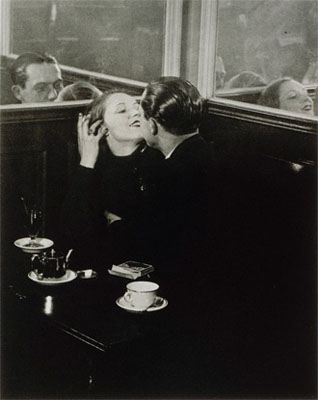
© ESTATE BRASSAÏ - RMN / CNAC - MNAM
Brassaï »
Brassaï (1899–1984) . A Major Retrospective
Exhibition: 9 Mar – 28 May 2007
Martin-Gropius-Bau
Niederkirchnerstr. 7
10963 Berlin

Gropius Bau
Niederkirchnerstr. 7
10963 Berlin
+49 (0)30-254860
post@gropiusbau.de
www.gropiusbau.de
Mon, Wed-Fri 12-19, Sat, Sun 10-19
Brassaï (1899-1984) - Photos A Major Retrospective Organizer: Berliner Festspiele and Centre Pompidou, Musée national d'art moderne – Centre de Création Industrielle, Paris Brassaï, who was born in 1899 in what was then the Hungarian town of Brassó, emigrated in 1920 to Berlin, where he studied at the Academy of Art in Charlottenburg and got to know artists such as Wassily Kandinsky, Oskar Kokoschka and László Moholy-Nagy. In 1924 he moved to Paris, where he began his career not as a photographer but as a journalist working mainly for German-language magazines. His friend André Kertész took photos to accompany his articles. It was his journalistic work that eventually led him to photography. During this time he also took an interest in literature and sculpture. In Paris in 1932 he adopted the pseudonym of Brassaï, derived from the name of his home town. The same year Brassaï published Paris by Night, a book that made him world-famous. The Museum of Modern Art in New York included his work in an exhibition entitled 'Photography: 1839-1937'. Using a Voigtländer camera, he was one of the first to master the art of night-time photography. Throughout his life Brassaï engaged in a wide variety of artistic activities. He produced sculptures, drawings and graphics, wrote works of literature and made films. In 1956 his Tant qu'il y aura des bêtes won the 'Most Original Film' award at the Cannes Film Festival. Picasso was particularly impressed by his drawings. Brassaï's Conversations with Picasso (1964) ranks among his major publications, which encompass 25 books und innumerable articles. Brassaï took his first photographs at exactly the same time as Surrealismus was beginning to gain a foothold in France. The influence of Surrealism was particularly marked in the realm of photography, as this medium was considered to play a key role in terms of the perception of reality. The exhibition features photos and drawings from the period between 1932 and 1960 and is divided into six chapters. Among the exhibits are Paris by Night (1932), Brassaï's work for the magazine Minotaure (1933-1939), the so-called Transmutations, drawings, pictures for the photo book Camera in Paris and the Graffiti series (1960). Brassaï became famous for his views of Paris by night. During the 1930s he wandered around the city at night either alone or in the company of writers such as Henry Miller and Raymond Queneau. The success of these views encouraged him to photograph daytime Parisian street scenes too. His involvement with the Surrealists, on the other hand, awakened his interest in the 'primitive' and led to the photographic series of 'involuntary sculptures' ('sculptures involontaires'). Items he came across, such as travel tickets, soap, books of matches and thimbles, became his subjects, taking on sculptural qualities. In the Transmutations Brassaï used exposed glass negatives as the raw material for drawings, scratching images onto the photographic plates and then exposing them a second time. He mainly transformed images of female nudes into graphic forms, turning them into guitar, violin or mandolin women and clearly demonstrating the influence of Pablo Picasso. Brassaï found the motifs for the Graffiti series in the scratched and scribbled surfaces of the city's dilapidated walls. He saw a connection between these accidental, anarchic graphic expressions and cave drawings. In this respect his work shows a distinct correlation with artistic positions such as the Art Brut (Outsider Art) of Jean Dubuffet and Jean Fautrier. Alongside his photographic work Brassaï constantly produced drawings and his sculptural oeuvre also grew steadily. His artistic credo was “to create something new and striking out of the banal and the ordinary, to show everyday life in such a way as to make it seem as though one is seeing it for the first time”. The recipient of numerous awards and prizes, Brassaï died in Beaulieu-sur-Mer on 7 July 1984. The exhibition was conceived and organized by the Centre Georges Pompidou in Paris. The catalogue was published by Alain Sayag and Annick Lionel-Marie and contains contributions by Jean-Jacques Aillagon, Brassaï, Gilberte Brassaï, Roger Grenier, Henry Miller, Jacques Prévert, Klaus Albrecht Schröder and Werner Spies. Catalogue Brassaï published by Alain Sayag and Annick Lionel-Marie, 319 pages, Brandstätter Verlag In the exhibition € 38 bookshop edition €69 ISBN: 978-3-85498-259-3

© ESTATE BRASSAÏ – RMN / CNAC - MNAM

© ESTATE BRASSAÏ - RMN / CNAC – MNAM

© ESTATE BRASSAÏ - RMN / CNAC – MNAM